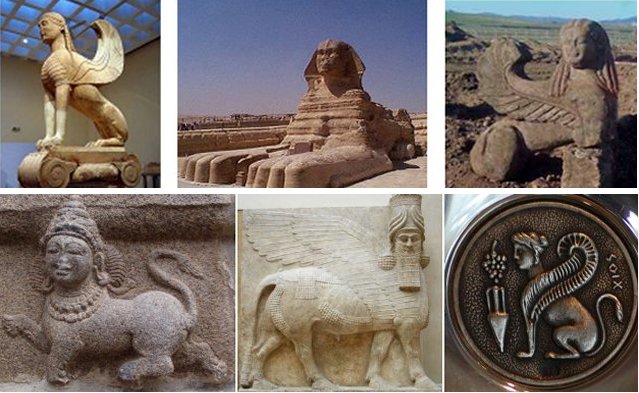Did The Great Sphinx Of Giza Have A Twin And Was It Destroyed By A Lightning Strike?
Ellen Lloyd - AncientPages.com - Few ancient structures have caused as much controversy as the Great Sphinx of Giza in Egypt. Scientists, archaeologists, and historians have debated its age, purpose, original appearance for a long time and the mysterious Egyptian structure raises more questions than answers.
Adding to all the unsolved puzzles, there is also a controversial theory that suggests the Sphinx of Giza once had a twin. If this is true, then what happened to the ‘second’ sphinx in Egypt? Where was it located, and how was it destroyed?
Did The Sphinx Have A “Twin Sister”?
The theory that the Great Sphinx of Giza may have had a twin was put forward by historians, Gerry Cannon and Malcolm Hutton.
Working with Egyptologist Bassam el-Shammaa, Cannon and Hutton are convinced there was once a second sphinx and think they have evidence to prove its existence.
The second sphinx was a female and the statue "disappeared" under unexplained circumstances. Cannon claims, however, that he managed to find the trail of the lost statue, analyzing the construction of the area around the pyramids.
Buried for thousands of years, the second sphinx is located on a second mound alongside the male sphinx, standing guard in front of one of the Great Pyramids.
The historians’ research pointed out that any sphinx had to have been carved out of natural rock long before sand covered the area. This means the statues must have been carved when the area had a much warmer and fertile climate. In ancient times, some thousand years ago, this vast area was fertile grassland.
Then something happened, and the Green Sahara turned into a desert.
Today, there is enough evidence to show that the Sahara desert was once a grassland ecosystem and was a much wetter place than it is today. The Great Sphinx and its companion must have been built during this time.
“The Sphinx had to have been carved when there was no sand there. You can’t carve a rock when it’s under sand. When it was not under sand was about 12,000 years ago and the Egyptians weren’t there,” Cannon said.
There are two sphinxes on the Dream Stele.
Another piece of evidence that speaks in favor of the second sphinx theory is the Dream Stele or Sphinx Stela from the time of Pharaoh Tuthmosis IV. Two sphinxes are clearly depicted on the Dream Stele.
Did A Lightning Strike Destroy The Second Sphinx?
El Shammaa has investigated images taken by NASA’s Endeavor Satellite. He thinks there is an underground anomaly near the great Sphinx, and those are the remains of the twin.
What destroyed the second sphinx is unknown, but El Shammaa speculated it could have been lightning.
Most Egyptologists Are Uninterested In The Second Sphinx Theory
Cannon and Hutton have many who support their second sphinx theory, but there is also great opposition among Egyptologists who think the idea is far-fetched.
In 2003, Cannot contacted Zahi Hawass, Egyptian archaeologist and former Minister of State for Antiquities Affairs and asked him to confirm his assumptions.
According to Cannon, Hawass's reply was simple and negative. Hawass stated he had no intentions co-operating with Cannon since he only worked with and assisted serious, respectable institutions.
The Sphinx - Important Symbol To Many Ancient Civilizations
The theory that there was once a second sphinx at Giza is not so crazy at all. Archaeological discoveries offer evidence that sphinxes do come in pairs. Without an open-minded approach, we can never solve the riddle of the twin sphinx. At present, the possible existence of a second unknown sphinx remains an unsolved ancient mystery.
We tend to associate the sphinx with Egypt, but this intriguing creature was well-known in many other ancient places. Ancient civilizations considered the sphinx to be a guardian of knowledge and symbol of riddles and intrigue.
Our member section offers a wealth of informative and insightful articles similar to this one. Upgrading to a premium membership gives you ad-free access to our entire collection of articles, allowing you to explore and enjoy our content without interruptions.
Written by Ellen Lloyd - AncientPages.com
Updated on July 1, 2024
Copyright © AncientPages.com All rights reserved. This material may not be published, broadcast, rewritten or redistributed in whole or part without the express written permission of AncientPages.com
More From Ancient Pages
-
 Carvings Of Mythological Masks Unearthed In Ancient Theater Of Stratonikeia
Archaeology | Nov 27, 2020
Carvings Of Mythological Masks Unearthed In Ancient Theater Of Stratonikeia
Archaeology | Nov 27, 2020 -
 Greek Discovery Of Stone Tools In Megalopolis Area Pushes Back Greece’s Archaeological Record Up To 250,000 Years
Archaeology | Jun 2, 2023
Greek Discovery Of Stone Tools In Megalopolis Area Pushes Back Greece’s Archaeological Record Up To 250,000 Years
Archaeology | Jun 2, 2023 -
 What Does DNA From 1,700-Year-Old Individuals Dated To The Three Kingdoms Period Tell About Ancient And Modern Korea?
Archaeology | Jun 21, 2022
What Does DNA From 1,700-Year-Old Individuals Dated To The Three Kingdoms Period Tell About Ancient And Modern Korea?
Archaeology | Jun 21, 2022 -
 On This Day In History: Myth Says Ancient Rome Was Founded By Romulus – On Apr 21, 753 BC
News | Apr 21, 2016
On This Day In History: Myth Says Ancient Rome Was Founded By Romulus – On Apr 21, 753 BC
News | Apr 21, 2016 -
 Great Viking Fortresses Built By King Harald Bluetooth
Featured Stories | Dec 12, 2022
Great Viking Fortresses Built By King Harald Bluetooth
Featured Stories | Dec 12, 2022 -
 Ancient Egyptians Invented World’s Oldest Egg Ovens And They Are Still In Use
Ancient History Facts | Jul 6, 2021
Ancient Egyptians Invented World’s Oldest Egg Ovens And They Are Still In Use
Ancient History Facts | Jul 6, 2021 -
 Timeline Of Greek Dark Ages And Renaissance Is Wrong, New Research Shows
Featured Stories | Nov 13, 2024
Timeline Of Greek Dark Ages And Renaissance Is Wrong, New Research Shows
Featured Stories | Nov 13, 2024 -
 How The Great Sphinx Gave Thutmose IV Power To Become Pharaoh
Civilizations | Jul 19, 2021
How The Great Sphinx Gave Thutmose IV Power To Become Pharaoh
Civilizations | Jul 19, 2021 -
 800-Year-Old Shipwreck Discovered Off Salento Coast, Italy
Archaeology | Dec 30, 2015
800-Year-Old Shipwreck Discovered Off Salento Coast, Italy
Archaeology | Dec 30, 2015 -
 Incredible Mammoth Ivory Male Head From Dolni Vestonice, Czech Dated To 26,000 BC
Artifacts | Jun 23, 2015
Incredible Mammoth Ivory Male Head From Dolni Vestonice, Czech Dated To 26,000 BC
Artifacts | Jun 23, 2015 -
 Ancient Urartu Settlement, Water Tunnel And Rock Tombs Found In Erzurum, Eastern Turkey
Archaeology | Dec 19, 2017
Ancient Urartu Settlement, Water Tunnel And Rock Tombs Found In Erzurum, Eastern Turkey
Archaeology | Dec 19, 2017 -
 Crannogs – Artificial Islands In Scotland Are Older Than Stonehenge
Archaeology | Jun 17, 2019
Crannogs – Artificial Islands In Scotland Are Older Than Stonehenge
Archaeology | Jun 17, 2019 -
 The Perplexing Story Of The Seven Continents And The Seven Mysterious Races – Distant Past – Part 1
Ancient Mysteries | May 9, 2022
The Perplexing Story Of The Seven Continents And The Seven Mysterious Races – Distant Past – Part 1
Ancient Mysteries | May 9, 2022 -
 Sutton Hoo Burials May Belong To Anglo-Saxons Who Fought For The Byzantine Empire – Professor Suggests
Archaeology | Jan 10, 2025
Sutton Hoo Burials May Belong To Anglo-Saxons Who Fought For The Byzantine Empire – Professor Suggests
Archaeology | Jan 10, 2025 -
 Early Homo Sapiens From Southeast Asia Could Adapt To A Rainforest Environment
Archaeology | Oct 17, 2021
Early Homo Sapiens From Southeast Asia Could Adapt To A Rainforest Environment
Archaeology | Oct 17, 2021 -
 Humans Started Wearing Clothes 100,000 To 500,000 Years Ago
Ancient History Facts | Mar 17, 2018
Humans Started Wearing Clothes 100,000 To 500,000 Years Ago
Ancient History Facts | Mar 17, 2018 -
 Never-Before-Seen Colorful Inscriptions And Reliefs At The Esna Temple, Egypt Revealed After Restoration
Archaeology | May 16, 2022
Never-Before-Seen Colorful Inscriptions And Reliefs At The Esna Temple, Egypt Revealed After Restoration
Archaeology | May 16, 2022 -
 On This Day In History: Alexander The Great Defeats Darius III Of Persia In The Battle Of The Granicus On May 22, 334 B.C.
News | May 22, 2016
On This Day In History: Alexander The Great Defeats Darius III Of Persia In The Battle Of The Granicus On May 22, 334 B.C.
News | May 22, 2016 -
 On This Day In History: Earthquake In Pompeii, Italy Occurred – On Feb 5, 62 AD
News | Feb 5, 2017
On This Day In History: Earthquake In Pompeii, Italy Occurred – On Feb 5, 62 AD
News | Feb 5, 2017 -
 Evidence Of Early Human Habitats Linked To Past Climate Shifts Discovered By Scientists
Archaeology | Apr 13, 2022
Evidence Of Early Human Habitats Linked To Past Climate Shifts Discovered By Scientists
Archaeology | Apr 13, 2022



